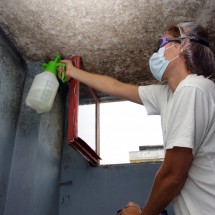Mold Inspection
What is Mold?
Mold is a fungal growth that is hard to see in small doses. It aids with the decomposition of leaves, wood and plants. When mold growth is visible, it can appear black, blue or green in color. Spores can become airborne and create a harmful environment.

Why is Mold Removal Important?
Serious illness can be caused by the inhalation of mold spores. If left untreated, mold can continue growing inside your body. Ingesting mold can lead to lung damage, brain damage, cancer or even death. Mold can form and grow extremely quickly and can remain undetected for long periods of time. Common trouble spots include basements, bathrooms, garages and anywhere else exposed to moisture.
How We Can Help
Mold Testing & Screening
What Can Cause Mold?
Our investigative services includes mold screening. Some common causes of mold are due to everyday tasks left unnoticed.
Frequent Causes of Mold Growth
- Basement or crawl space flooding & water intrusion
- Closeness to lake, river, or ocean
- Clothes dryer exhausting into walls or attic
- Construction defects & poor workmanship
- Firewood indoors
- Flooding
- High indoor humidity [60%+]
- Indoor plants
- Overflow from tubs, showers, sinks, & toilets
- Landscaping mistakes like mulch & plant glut & Lot grading downward to home
- Leaky roof
- Venting inadequacies in kitchen & bathrooms
- Sewage pipe leaks
- Siding water leaks
- Water supply pipe leaks
- Wet clothes
Toxic Mold Screening, Testing, & Evaluation
One Source Environmental offers complete mold and mildew screening, testing, and evaluation services. Mold is a common problem in homes and buildings today. It can be caused by a number of things, and the variables involved can be staggering. If you suspect a mold or mildew problem in your residence or place of business, call OSE to perform a mold screening. It won’t take very long at all, and the health benefits are immeasurable. One Source Environmental’s mold screenings can provide you with peace of mind required for a positive living or working environment. The health risks from a mold problem can cause a variety of different symptoms from general allergies to lethal reactions, if the concentration is high enough. Screening can be a quick process, often starting with just a glance to determine how widespread the mold is, if at all.
The assessment process then takes a quick turn into a normal inspection. Once OSE has determined that your structure needs to be evaluated properly, we test and screen to figure out what types of mold are present, as well as how to get rid of them. Toxic mold can play an especially dangerous role in these types of infestations. It is beneficial to catch mold growth before health complaints and ailments arise. OSE can help you fix the problem as well, by informing you of how to remove whatever mold is found present. The best ways to kill mold and mildew can be rather complicated, as different species can require completely different approaches to find the proper remedies. Testing for mold is imperative! If you suspect or see mold at your residence or place of work, notify the proper attendant to give One Source Environmental a call today. After all, it’s good for your health.
10 Mold Facts for Homeowners, Landlords, Tenants & Employers
- Airborne mold spores are everywhere both indoors and outdoors. Resident and employee health is at serious risk if there are elevated levels of mold spores indoors, as compared to an outdoor mold control test.
- The most dangerous indoor molds are Alternaria, Aspergillus, Chaetomium, Cladosporium, Fusarium, Mucor, Penicillium, and Stachybotrys. Mold testing and mold laboratory analysis are required to identify specific mold species.
- Mold spores can cause serious health problems even if the spores are dead or dormant (inactive while waiting for more moisture to resume growth). Even the smell of dead or dormant mold can make some mold-sensitive persons ill.
- It is impossible to get rid of all mold spores indoors. Some mold spores will always be present in house dust and floating in the air.
- The mold spores will not grow into mold colonies if there is insufficient moisture. Indoor mold growth can and should be prevented or controlled by controlling moisture indoors. If organic materials are wet for more than 24 hours, mold growth can begin.
- Mold grows by eating and destroying organic building materials and other cellulose-based materials such as carpeting, upholstery, and clothing. The longer that mold grows, the more mold damage to the building.
- Cellulose is the main substance in the cell walls of plants (and thus of wood), and it is used in the manufacture of many organic building materials such as drywall, plasterboard, plywood substitutes, and ceiling tiles.
- Mold can grow hidden and undetected inside wall and ceiling cavities; beneath wallpaper, paneling, and carpeting; and inside heating and cooling equipment and ducts, attics, crawl spaces, and basements.
- Mold growth is often the result of a structural or construction defect, or of maintenance neglect, that allows moisture to enter the building.
- The owner or employer must first fix the water problem (roof leak, plumbing leak, high indoor humidity) that enables the mold to grow. Effective mold remediation requires killing the mold with an EPA-registered fungicide, removing it, and treating the cleaned area with an EPA-registered preventive fungicidal coating.
